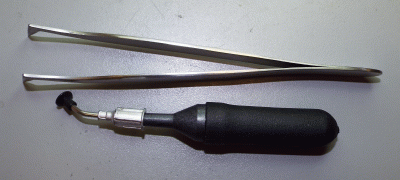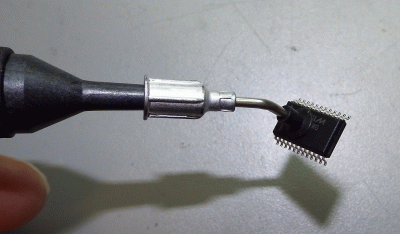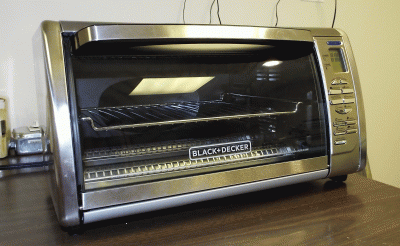——————————————
REFLOW FOR DUMMIES
——————————————I'm sure that anyone who had the dubious distinction of interacting with MS-DOS back in the day recalls the classic tome
DOS for Dummies. The author, Dan Gookin, had suffered through the agony of figuring out what those DOS commands did and recorded his findings for posterity in what was a top-seller by computer book standards. The followup book,
Windows for Dummies, in which Andy Rathbone suffered through similar aches and pains, is believed to be the best-selling computer instructional book of all times, with an estimated 15 million copies sold. Both of these publications went to the trouble to present technical material in a manner that would not intimidate a non-technical user, which had a lot to do with their sales successes.
Building on the
DOS for Dummies premise—although few dummies inhabit 6502.org, I've started this topic on my experiences in attempting to reflow printed circuit boards (PCB) at home, using what I perceive to be readily available and inexpensive tools and supplies, as well as reasonably simple procedures. My ultimate goal is to be able to utilize fine pitch, surface mounted devices in my future designs, which holds the promise of more hardware on a smaller board, as well as access to programmable logic with a gazillion output pins. I'm a "dummy" when it comes to reflow, so I'm essentially working from scratch.
For the purpose of getting familiar with hobby reflowing, I'm going to build a copy of POC V1.1, which makes a good test base for this purpose. POC V1.1 is a functional design, which means if the finished assembly doesn't work or is unstable it'll likely be due to my reflow methods—the design itself won't be in question.
Here are the items that will be the victims of my first attempt at reflow:
Attachment:
File comment: POC V1.1 Printed Circuit Board
 pcb.gif [ 1.32 MiB | Viewed 2074 times ]
pcb.gif [ 1.32 MiB | Viewed 2074 times ]
Attachment:
File comment: Surface-Mount Devices
 devices.gif [ 1.65 MiB | Viewed 2074 times ]
devices.gif [ 1.65 MiB | Viewed 2074 times ]
The devices are a MAX-238 in an SOIC-24 package and an ISSI 128KB SRAM in an SOJ32 package. The scale in the second photo is in inches.
THE REFLOW PROCESSBefore continuing, and for the benefit of those who aren't familiar with the reflow process and aren't inclined to wander around the Internet seeking information on it, I'll quickly explain. Reflowing involves heating the PCB and surface mount devices to a temperature sufficient to melt the solder (called "reflow") that is placed on the PCB's pads at the time of manufacture. The method by which the assembly is heated varies, however, a reflow oven is generally used for mass or short-run production purposes. A hot air pencil is often used for prototype/rework/repair purposes.
Reflow is either the traditional tin/lead alloy, usually 63/37, or an unleaded alloy to comply with
RoHS standards. RoHS-compliant solders have a higher melting temperature than their leaded equivalents and probably should be avoided for hobby work. My experiences with repairing assemblies that are RoHS compliant have been mixed—"cold" solder joints tend to be a problem.
Immediately before the actual reflow process, a paste consisting of a mixture of solder particles and flux is applied to the pads to which devices are to be soldered. The parts are then placed on the PCB and the assembly is heated to begin the process. The assembly's temperature is elevated in steps so abrupt thermally-induced expansion doesn't occur to parts, which could be fatal to them. The pattern followed during heating is referred to as the "thermal profile."
When reflowing temperature is finally attained, the solder in the paste melts along with the reflow on the PCB, providing the necessary amount of solder to complete the joint. The assembly is kept at reflow temperature long enough to assure that the solder/reflow flows all around and under the pins on the parts being soldered to achieve a solid bond. The solder mask on the PCB helps to prevent flow from causing bridges between adjacent pads. Following reflow, the assembly is allowed to cool to well below reflow temperature before subsequent handling.
TOOLS & EQUIPMENTIn order to carry out the reflow process at home, you will need some stuff:
- Chip Handlers
Surface-mount devices are dinky compared to through-hole equivalents, which creates some challenges in handling them. Following the application of solder paste to your PCB, you need to accurately place your parts on the pads. For that task, tweezers and/or a suction pick are useful.
Attachment:
File comment: Suction Pick & Tweezers
 tools.gif [ 2.34 MiB | Viewed 2074 times ]
tools.gif [ 2.34 MiB | Viewed 2074 times ]
The suction pick, called a "Handi-Vac," is available from Edmund Optics. It comes with several attachments, which are basically little suction cups. After placing the suction cup on the device package, you squeeze and release the bulb to pick the part. Once the part is in place you again squeeze the bulb to release it. I found that wetting the suction cup immediately before picking a part improved the grip, giving me more time to handle the part before loss of suction.
Attachment:
File comment: Using Suction Pick
 chip_handling.gif [ 1.31 MiB | Viewed 2074 times ]
chip_handling.gif [ 1.31 MiB | Viewed 2074 times ]
In the above, I have picked the MAX-238. The grip was maintained for about 30 seconds, sufficient time to place the part if you aren't too clumsy. 
In lieu of a suction pick, a pair of eyebrow tweezers may be used for handling parts. They, of course, won't work well with larger packages. I found that handling an SOJ32 device with tweezers was awkward.
- Source of Heat
There are several means by which you can heat your PCB assembly for reflowing. Some hobbyists have had success with using an electric frying skillet. Others have used hot air guns and infrared lamps. I decided to use an actual oven, mostly due to the control that it offers. Whatever you do use, keep in mind that peak reflow temperature is around 450° F (232° C), which means your source of heat must be capable of attaining that temperature and maintaining it for at least 30-45 seconds. As will be seen when I get to the procedure for reflowing, the ability to accurately control temperature will be important.
Attachment:
File comment: Counter-Top Convection Oven
 reflow_oven.gif [ 1.97 MiB | Viewed 2074 times ]
reflow_oven.gif [ 1.97 MiB | Viewed 2074 times ]
The above is a Black & Decker digital counter-top convection oven, model CT06335S. I spent some time researching suitable ovens before selecting this particular one, which replaces an old Proctor-Silex unit I had that suffered a heating element failure and proved to be too expensive to repair.
Useful features of this unit are its infrared heating system, with elements located in both the unit's base and top, its convective capabilities, which produces a more even heating of the interior and contents, and a real-time temperature display, which is handy for monitoring the process. Although I have no plans to reflow one, an ATX motherboard will fit in this oven. I'm not advocating that you get this particular unit—any oven with similar features will be a good candidate for the job.
A word of caution: an electric counter-top oven typically draws quite a bit of juice. This Black & Decker unit consumes 1500 watts when heating and not unexpectedly, radiates quite a bit of heat into the room. A 1500 watt oven generates about 5000 BTUs, which I found was enough to elevate the temperature in my shop several degrees after about 10 minutes of continuous operation.
Odors may develop during the reflow process, which will probably smell like roses to you, but probably something a little less pleasant to the other members of your family.

Please keep all that in mind when you choose a location to set up your reflow facility.
In my next post, I'll go into prepping the PCB and placing the parts.
——————————————
EDIT: Fixed two typos.







